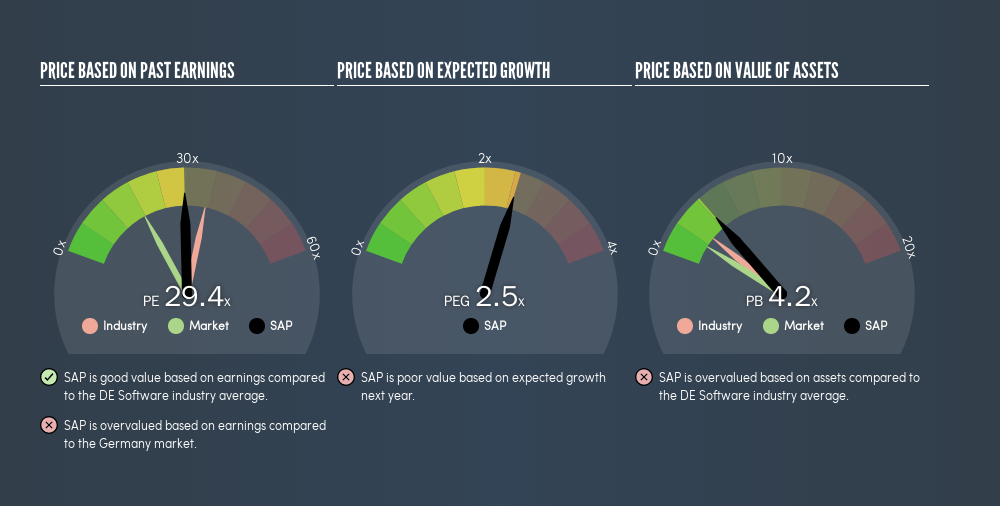This article is written for those who want to get better at using price to earnings ratios (P/E ratios). We'll look at SAP SE's (FRA:SAP) P/E ratio and reflect on what it tells us about the company's share price. SAP has a P/E ratio of 29.44, based on the last twelve months. That corresponds to an earnings yield of approximately 3.4%.
Check out our latest analysis for SAP
How Do I Calculate SAP's Price To Earnings Ratio?
The formula for price to earnings is:
Price to Earnings Ratio = Price per Share ÷ Earnings per Share (EPS)
Or for SAP:
P/E of 29.44 = €100.66 ÷ €3.42 (Based on the year to December 2018.)
Is A High P/E Ratio Good?
A higher P/E ratio implies that investors pay a higher price for the earning power of the business. All else being equal, it's better to pay a low price -- but as Warren Buffett said, 'It's far better to buy a wonderful company at a fair price than a fair company at a wonderful price.'
How Growth Rates Impact P/E Ratios
Earnings growth rates have a big influence on P/E ratios. Earnings growth means that in the future the 'E' will be higher. That means unless the share price increases, the P/E will reduce in a few years. A lower P/E should indicate the stock is cheap relative to others -- and that may attract buyers.
SAP's earnings per share grew by -2.1% in the last twelve months. And its annual EPS growth rate over 5 years is 6.2%.
How Does SAP's P/E Ratio Compare To Its Peers?
The P/E ratio indicates whether the market has higher or lower expectations of a company. The image below shows that SAP has a lower P/E than the average (33.4) P/E for companies in the software industry.

SAP's P/E tells us that market participants think it will not fare as well as its peers in the same industry. Many investors like to buy stocks when the market is pessimistic about their prospects. If you consider the stock interesting, further research is recommended. For example, I often monitor director buying and selling.
A Limitation: P/E Ratios Ignore Debt and Cash In The Bank
The 'Price' in P/E reflects the market capitalization of the company. That means it doesn't take debt or cash into account. Hypothetically, a company could reduce its future P/E ratio by spending its cash (or taking on debt) to achieve higher earnings.
Such expenditure might be good or bad, in the long term, but the point here is that the balance sheet is not reflected by this ratio.
How Does SAP's Debt Impact Its P/E Ratio?
SAP's net debt is 2.0% of its market cap. So it doesn't have as many options as it would with net cash, but its debt would not have much of an impact on its P/E ratio.
The Verdict On SAP's P/E Ratio
SAP trades on a P/E ratio of 29.4, which is above the DE market average of 18. Given the debt is only modest, and earnings are already moving in the right direction, it's not surprising that the market expects continued improvement.
Investors should be looking to buy stocks that the market is wrong about. People often underestimate remarkable growth -- so investors can make money when fast growth is not fully appreciated. So this freevisualization of the analyst consensus on future earnings could help you make the right decision about whether to buy, sell, or hold.
But note: SAP may not be the best stock to buy. So take a peek at this freelist of interesting companies with strong recent earnings growth (and a P/E ratio below 20).
We aim to bring you long-term focused research analysis driven by fundamental data. Note that our analysis may not factor in the latest price-sensitive company announcements or qualitative material.
If you spot an error that warrants correction, please contact the editor at editorial-team@simplywallst.com. This article by Simply Wall St is general in nature. It does not constitute a recommendation to buy or sell any stock, and does not take account of your objectives, or your financial situation. Simply Wall St has no position in the stocks mentioned. Thank you for reading.
About DB:SAP
Flawless balance sheet with proven track record and pays a dividend.
Similar Companies
Market Insights
Community Narratives




